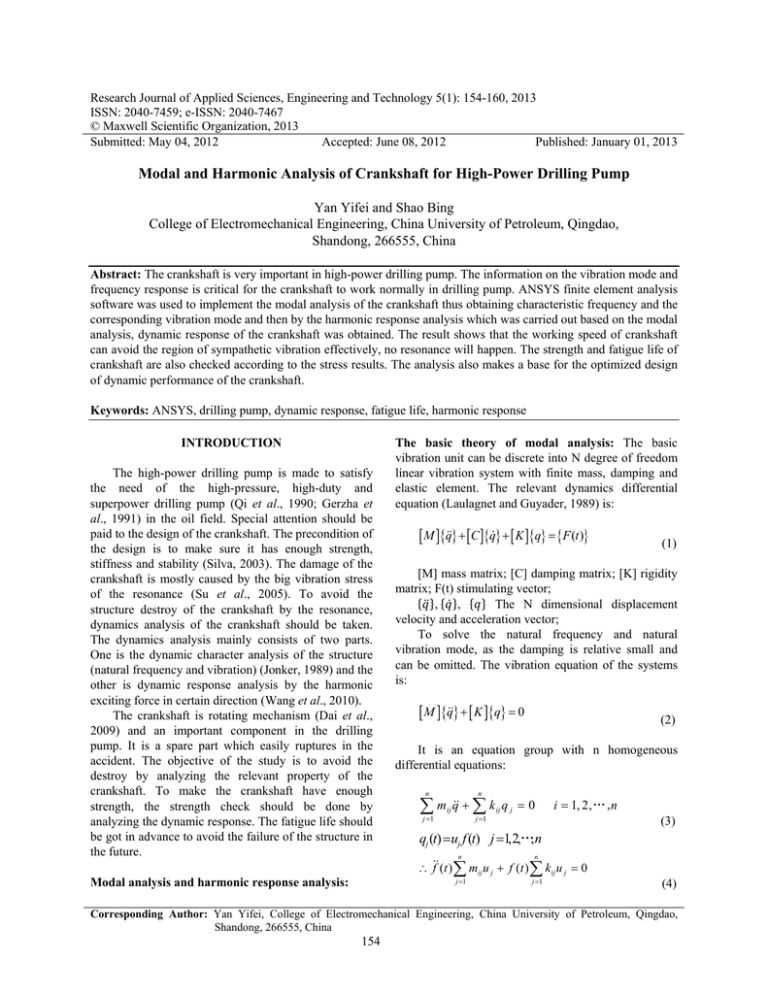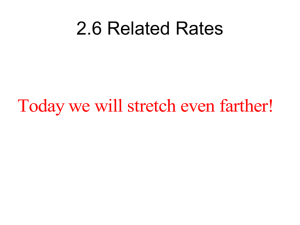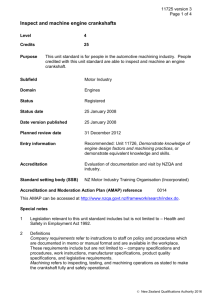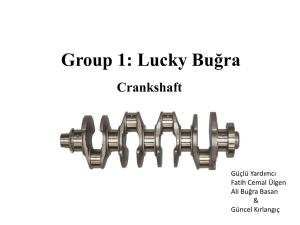Document 13290246
advertisement

Research Journal of Applied Sciences, Engineering and Technology 5(1): 154-160, 2013 ISSN: 2040-7459; e-ISSN: 2040-7467 © Maxwell Scientific Organization, 2013 Submitted: May 04, 2012 Accepted: June 08, 2012 Published: January 01, 2013 Modal and Harmonic Analysis of Crankshaft for High-Power Drilling Pump Yan Yifei and Shao Bing College of Electromechanical Engineering, China University of Petroleum, Qingdao, Shandong, 266555, China Abstract: The crankshaft is very important in high-power drilling pump. The information on the vibration mode and frequency response is critical for the crankshaft to work normally in drilling pump. ANSYS finite element analysis software was used to implement the modal analysis of the crankshaft thus obtaining characteristic frequency and the corresponding vibration mode and then by the harmonic response analysis which was carried out based on the modal analysis, dynamic response of the crankshaft was obtained. The result shows that the working speed of crankshaft can avoid the region of sympathetic vibration effectively, no resonance will happen. The strength and fatigue life of crankshaft are also checked according to the stress results. The analysis also makes a base for the optimized design of dynamic performance of the crankshaft. Keywords: ANSYS, drilling pump, dynamic response, fatigue life, harmonic response INTRODUCTION The high-power drilling pump is made to satisfy the need of the high-pressure, high-duty and superpower drilling pump (Qi et al., 1990; Gerzha et al., 1991) in the oil field. Special attention should be paid to the design of the crankshaft. The precondition of the design is to make sure it has enough strength, stiffness and stability (Silva, 2003). The damage of the crankshaft is mostly caused by the big vibration stress of the resonance (Su et al., 2005). To avoid the structure destroy of the crankshaft by the resonance, dynamics analysis of the crankshaft should be taken. The dynamics analysis mainly consists of two parts. One is the dynamic character analysis of the structure (natural frequency and vibration) (Jonker, 1989) and the other is dynamic response analysis by the harmonic exciting force in certain direction (Wang et al., 2010). The crankshaft is rotating mechanism (Dai et al., 2009) and an important component in the drilling pump. It is a spare part which easily ruptures in the accident. The objective of the study is to avoid the destroy by analyzing the relevant property of the crankshaft. To make the crankshaft have enough strength, the strength check should be done by analyzing the dynamic response. The fatigue life should be got in advance to avoid the failure of the structure in the future. Modal analysis and harmonic response analysis: The basic theory of modal analysis: The basic vibration unit can be discrete into N degree of freedom linear vibration system with finite mass, damping and elastic element. The relevant dynamics differential equation (Laulagnet and Guyader, 1989) is: M q Cq K q F (t ) (1) [M] mass matrix; [C] damping matrix; [K] rigidity matrix; F(t) stimulating vector; , , The N dimensional displacement velocity and acceleration vector; To solve the natural frequency and natural vibration mode, as the damping is relative small and can be omitted. The vibration equation of the systems is: M q K q 0 (2) It is an equation group with n homogeneous differential equations: n m j 1 n ij q k ij q j 0 i 1, 2, … ,n j 1 (3) qj (t) uj f (t) j 1,2,…, n n n j 1 j 1 f (t ) mij u j f (t ) k ij u j 0 (4) Corresponding Author: Yan Yifei, College of Electromechanical Engineering, China University of Petroleum, Qingdao, Shandong, 266555, China 154 Res. J. Appl. Sci. Eng. Technol., 5(1): 154-160, 2013 q M n f (t ) f (t ) k u j m u j j 1 n ij ij j 1 K q M 1 1 F0 cos t (12) Let (5) The equation shows that the time function can be separated with the space function. The left of the function have no relations with subscript i while the right of the function has no relations with time. Supposing the ratio of two functions is a constant λ, we can have: f (t ) f (t ) 0 02 M 1 K q 02 q f 0 M F0 1 f 0 cos t (13) We can solve the equation: q(t ) A0e t cos(t ) A cos( pt ) (14) (6) The steady state response: n (ki j 1 j mij )u j 0 q ( t ) (7) The matrix form is: K u M u 0 (8) To make the equation has a non-zero solution, the determinant of the coefficient matrix is zero: K M 0 (9) The general solution of the function is: n n r 1 r 1 q(t ) q(t )r Ar ur sin(nrt r ) u Asin(nt ) (10) The result shows that the natural frequency is decided by the stiffness and the mass of the system. The non-damping vibration with N degree of freedom is a linear combination of n simple harmonic oscillation with natural frequency. The basic theory of the harmonic response analysis: Any cyclic load will bring the cyclic response (harmonic response) of the structure system. The aim of the analysis is to calculate the response of the structure with different frequency and get the curve of the response value at different frequency. The result can be the bad effect of the forced vibrations. The harmonic response analysis is as follows: M q K q F0 c o s t (11) A cos( t ) (15) The finite element model of the crankshaft: The modal of crankshaft for the finite element analysis is 3NB-2200. According to the real size of the crankshaft for ZY3NB2200 drilling pump, we simplify the solid calculation modal to divide the grid. The finite solid modal and its element modal of the crankshaft are shown in Fig. 1. The grid is divided using SOLID45 unit by the free lattice method (Nath and Ghosh, 1980). The material of the crankshaft is ZG25MnVCu. The material property is shown in Table 1. The two simple bearings are placed in the shoulder of base bearing. A constraint in the direction of rotation is made in the connecting parts of the gearwheel (Feng et al., 2007). The modal analysis of the crankshaft: The crankshaft is the high speed rotating member in the drilling pump. We take the modal analysis and solve the natural frequency and the corresponding vibration modal (Kim et al., 2008). The modal analysis is comprised by the model building, loading, solving and post processing of the extended modal. The Block Lanczo method (Gupta and Lawson, 1988) is adopted as the modal analysis method. The vibration of the structure can be taken as the linear combination of multiple natural mode of vibration. The vibration mode with low order has more dynamic effect than the mode with high order (Khemili and Romdhane, 2008). The dynamic character is depended by the structure of low order. The first eight order natural frequency of the crankshaft is shown in Table 2. 155 Res. J. Appl. Sci. Eng. Technol., 5(1): 154-160, 2013 Table 1: Material properties of crank shaft Elasticity modulus/MPa Poisson ratio 206000 0.3 Density/kg/m3 7800 Yield limit/MPa 550 Table 2: The first 8 order natural frequency and period of the crankshaft Order 1 2 3 4 Frequency (Hz) 51.049 243.1100 310.0700 334.8900 Period (sec) 0.020 0.0041 0.0032 0.0030 5 358.0700 0.0028 Allowable stress/MPa 500 6 444.8100 0.0023 7 456.3600 0.0022 8 493.8300 0.0020 By curve fitting of the data in the Table 1, The curves about the order with the frequency and period in the free vibration of connecting rod are shown in Fig. 2. The order of the vibration is relatively in linear relation with the natural frequency. By curve fitting, we can get: f 94.35 196.9n 27.02n2 1.45n3 (16) The order is in exponent relation with the Period, we have: T 0.002 0.005e n / 2.16 0.43e n / 0.29 (a) solid modal (17) The correlation coefficient of the Eq. (16) and (17) is R = 0.97 and R = 0.99 relatively. So the two equations can reflect the relation between the order and the frequency. We can anticipate the frequency and period in the free vibration of the crankshaft. The different orders of the crankshaft vibration mode are shown in Fig. 3 The frequency of stroke for the 3NB-2200 drilling pump is 120 time/min. The excited frequency of the crankshaft is 2 Hz. The first order natural frequency of the crankshaft by modal calculation is 51.049 Hz which is far larger than 2 Hz. So the crankshaft will not have resonance while the drilling pump is working. (b) grid modal 650 600 550 500 450 400 350 300 250 200 150 100 50 0 Frequency (Hz) Period (sec) 1 2 3 6 7 4 5 Exponent number (n) 8 9 10 0.022 0.020 0.018 0.016 0.014 0.012 0.010 0.008 0.006 0.004 0.002 0.000 Period (T)/sec Frequency (f)/Hz Fig. 1: The solid modal and grid modal of the crankshaft Fig. 2: The relation curve of the order with different frequency period in the free vibration of the crankshaft Harmonic response analysis: After the modal analysis, we make the harmonic response analysis. The boundary condition of the analysis is the same with the modal analysis (Loannides and Grootenhuis, 1979). The resonance peak on the three-throw crankshaft is 751.4 kN. The place is in the contact point between the crankshaft and the connecting rod. The phase division is 120º. The frequency span is from 0 to 500 Hz. 5 points are taken by the equal interval in the central axis of the crankshaft. The change of the crankshaft displacement can be got from the change of the 5 points. The displacements in the x, y and z direction are calculated apart and the results are shown in Fig. 4. From the Fig. 4, we can see that when the external load frequency is 50-60 or 230-260 Hz, the crankshaft displacement in x direction is suddenly bigger. It is because that the frequency domain is near the first and second natural frequency. The resonance occurs and the displacement in x direction becomes bigger. When the 156 Res. J. Appl. Sci. Eng. Technol., 5(1): 154-160, 2013 (a) The first order (b) The second order (c) The forth order (d) The seventh order (e) The ninth order (f) The tenth order Fig. 3: The different order of vibration mode 157 1.250 1.125 1.000 0.875 0.750 0.625 0.500 0.375 0.250 0.125 0 (x10** -4) Displacement 1 Displacement 4 Amp1 Value Res. J. Appl. Sci. Eng. Technol., 5(1): 154-160, 2013 Displacement 3 Displacement 5 50 100 150 200 250 Displacement 2 550 350 450 300 500 400 Amp1 Amp1 (a) Displacement in x direction 5.0 4.5 4.0 3.5 3.0 2.5 2.0 1.5 1.0 0.5 0 2.0 1.8 1.6 1.4 1.2 1.0 0.8 0.6 0.4 0.2 0 (x10** -4) Displacement 3 Displacement 1 Displacement 4 Displacement 2 Displacement 5 50 150 100 200 250 550 350 450 300 500 400 Amp1 (b) Displacement in y direction (x10** -4) Displacement 3 Displacement 4 Displacement 5 Displacement 2 Displacement 1 50 100 150 200 250 550 450 350 300 500 400 Amp1 (c) Displacement in z direction Fig. 4: The curve of crankshaft displacement in different direction as the load frequency changes Fig. 5: Position of loading and restriction of crank shaft Fig. 6: Compression stress distribution of crank shaft under work pressure of 60 MPa with rotor angle 90° 158 Res. J. Appl. Sci. Eng. Technol., 5(1): 154-160, 2013 equivalent stress of sampled six points are shown in Table 3. When work pressure is 52 and 60 MPa, Fig. 7 shows the corresponding maximum equivalent stress of Crank A, B, C and the crankshaft with the crank angle. From Fig. 7, when the work pressure is different, the stress variation tendency is relatively the same. When rotor angle is 180º and 360º, the stress of Crank A has a big leap. This is because the piston changes to discharge process from suction process. The force of the connecting bar acting on the crankshaft becomes bigger. So the maximum stress of Crank A increases suddenly. Similarly, when the piston changes to suction process from discharge process, the maximum stress of Crank A decreases sharply. The stress of Crank C becomes bigger in 60º and smaller in 240º. The reason of change is the same with Crank A. According to the stress state of different case, the maximum equivalent stress of crankshaft is 166 MPa when work pressure is 60 MPa. The allowable stress of external load frequency is 230-260 Hz, the crankshaft displacement in y direction is bigger as the frequency domain is near the first natural frequency and bending resonance occur. Similarly, displacement in z direction is bigger in the frequency domain 340-360 Hz. In reality, these frequency domains should be avoided to prevent the occurrence of resonance (Tsuchiya and Nagashima, 2003). Strength check and fatigue analysis: Strength check of the crankshaft: As the structure and stress is relatively complex, the stress of different load case should be checked. The calculation is done every 30° of crank angle. The force during the moving process is exerted in the three crank handle. The details are shown in Fig. 5. When work pressure is 60 MPa and rotor angle 90º, compression stress distribution of crankshaft is shown in Fig. 6 The strength of crankshaft is checked by the fourth strength theory. Two points are picked in each of the three cranks. When the pump pressure is 52 MPa, the Crank-B Crank-maximum Equivalent stress/MPa 110 100 90 80 70 60 50 40 140 120 100 80 60 (a) Under pressure 52 MPa 30 0 30 0 Crank angle 250 20 0 0 33 0 36 0 24 0 270 300 60 90 12 0 15 0 18 0 210 Crank angle 15 0 40 30 0 30 Crank-B Crank-maximum 160 10 0 Equivalent stress/MPa Crank-A Crank-C a 50 120 Crank-A Crank-C (b) Under pressure 60 MPa Fig. 7: Variation curve of crankshaft’s maximum equivalent stress with the crank angle under different pressure Table 3: Equivalent stress distribution under work pressure of 52 MPa Rotor angle Equivalent stress of A\MPa Equivalent stress of B\MPa 0° 34.5 36.9 97.6 99.800 30° 37.6 39.6 86.5 88.800 42.7 41.3 83.7 87.500 60° 90° 47.4 44.2 81.7 83.300 120° 48.6 50.1 38.6 37.200 51.2 53.1 41.4 40.600 150° 180° 78.2 81.6 43.7 43.300 210° 89.9 45.0 45.9 63.700 240° 98.7 49.6 49.4 67.000 86.2 54.0 53.4 73.610 270° 77.5 86.3 80.9 82.178 300° 330° 70.2 75.3 87.1 89.726 360° 34.5 36.9 97.6 99.892 Table 4: Result of fatigue analysis of crankshaft Chosen points Equivalent stress\MPa 1 166.0 2 165.1 3 159.3 Equivalent stress of C\MPa 52.2 52.8 55.5 56.1 87.0 88.8 97.6 99.1 105.7 102.9 99.1 97.7 95.0 93.2 87.1 85.3 38.4 39.9 41.3 43.9 43.9 44.8 47.9 48.1 50.9 51.2 Cycle index 2×108 2×108 2×108 159 Maximum equivalent stress\MPa 102.5 98.8 97.7 109.1 110.1 105.2 105.6 97.8 106.2 95.1 99.0 101.3 102.5 Fatigue ratio 0.06980 0.07120 0.06030 Fatigue life 2.092×109 1.839×109 2.331×109 Res. J. Appl. Sci. Eng. Technol., 5(1): 154-160, 2013 the material is 500 MPa. So the design can satisfy the strength requirement. Fatigue analysis: According to the results, the fatigue strength of crankshaft need to be checked when the work pressure is 52 MPa. The easily fatigue points in the crankshaft are taken to be analyzed. The results of three points is shown in Table 4. From the Table 4, the fatigue life which the crankshaft can endure is not more than 1.839×109. Supposing the life of the crankshaft is 5 years (Taylor et al., 1997). The working month, working day and working hour are 12 months/year, 20 days/month and 16 h/day, respectively. The theoretic frequency of stroke of the drilling pump is 105 time/min. Then the frequency of load stroke which the crankshaft endures is: 5×12×20×16×105×60 = 1.15×108. So the crankshaft satisfies the need of fatigue life. CONCLUSION By the finite element analysis software ANSYS we study the natural vibration character of the crankshaft for the 3NB-2200 drilling pump. We get the first eight order natural frequency of the crankshaft and its vibration mode. The mode calculation truly reflects the natural character of crankshaft and provides the basic theory for improving the crankshaft. The crankshaft frequency and the periodic data are obtained by the modal analysis and the relationship between the frequency and the order is determined Based on the modal calculation, the response of the crankshaft is analyzed by the harmonic exciting force. The vibration character by the harmonic force is gained The frequency of stroke for the 3NB-2200 drilling pump is 120 time/min. The excited frequency of the crankshaft is 2 Hz. It is far below the natural frequency and can avoid the resonance frequency domain. So the crankshaft will not have resonance while the pump works normally According to the fourth strength theory, the maximum equivalent stress of crankshaft is far below the allowable stress. So the design satisfies the strength requirement. The fatigue analysis is done when work pressure is 52 MPa. It is proved that the crankshaft can work normally in 5 years. REFERENCES Dai, J.J., Z.H. Wang, B. Meng, S. Yang and J. Zhang, 2009. Stress analysis and strength calculation of reciprocating pump crankshaft. Oil Field Equipment, 11(4): 55-62. Feng, P.F., L. Sheng, Z.J. Wu and D.W. Yu, 2007. Study on the dynamic load and mechanical property of the plunger pump crankshaft. Mach. Design Manuf., 65(5): 61-64. Gerzha, S.P., F.M. Khon, M.M. Bondarenko and V.K. Chistyakov, 1991. Methods of calculation and results of investigations of a fabricated drilling pump crankshaft. Chem. Petrol. Eng., 27(4): 205208. Gupta, K.K. and C.L. Lawson, 1988. Development of a block Lanczos algorithm for free vibration analysis of spinning structures. Int. J. Num. Methods Eng., 26(5): 1029-1037. Jonker, B., 1989. A finite element dynamic analysis of spatial mechanisms with flexible links. Comp. Meth. Appl. Mech. Eng., 76(1): 17-40. Khemili, I. and L. Romdhane, 2008. Dynamic analysis of a flexible slider-crank mechanism with clearance. Eur. J. Mech. -A/Solids, 27(2): 882-898. Kim, C.W., S.N. Jung and J.H. Choi, 2008. Automotive structure vibration with component mode synthesis on a multi-level. Int. J. Automot. Technol., 9(1): 119-122. Laulagnet, B. and J.L. Guyader, 1989. Modal analysis of a shell's acoustic radiation in light and heavy fluids. J. Sound Vib., 131(3): 397-415. Loannides, E. and P. Grootenhuis, 1979. A finite element analysis of the harmonic response of damped three-layer plates. J. Sound Vib., 67(2): 203-218. Nath, P.K. and A. Ghosh, 1980. Steady state response of mechanisms with elastic links by finite element methods. Mech. Mach. Theory, 15(3): 199-211. Qi, Y.G., L.S. Shi and F.S. Zhou, 1990. Two Theorerical problems in drill pump design. China Petrol. Mach., 9(1): 34-41. Silva, F.S., 2003. Analysis of a vehicle crankshaft failure. Eng. Fail. Anal., 10(5): 605-616. Su, Y.N., C. Zhou and X.R. Dou, 2005. Operation characteristics analysis and process parameters selection of air drilling. Petrol. Expl. Dev., 2(1): 66-71. Taylor, D., A.J. Ciepalowicz, P. Rogers and J. Devlukia, 1997. Prediction of fatigue failure in a crankshaft using the technique of crack modeling. Fatigue Fracture Eng. M. St., 20(1): 13-21. Tsuchiya, K. and K. Nagashima, 2003. A Calculation method for indicated mean effective pressure based on harmonic analysis of pressure waveform. Int. J. Eng. Res., 4(2): 87-102. Wang, F.M, J.Y. He, L.F. Zhao, Z.M. Li and H.C. Ding, 2010. Vibration mode analysis of roots blower's shell. Noise Vib. Cont., 3(1): 45-52. 160


